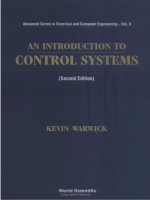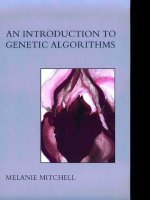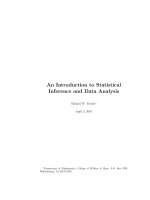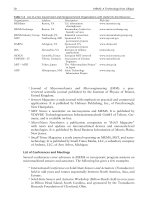- Trang chủ >>
- Khoa Học Tự Nhiên >>
- Vật lý
statistical field theory an introduction to exactly solved models in statistical physics nov 2009
Bạn đang xem bản rút gọn của tài liệu. Xem và tải ngay bản đầy đủ của tài liệu tại đây (4.34 MB, 778 trang )
Statistical Field Theory
This page intentionally left blank
Statistical Field Theory
An Introduction to Exactly Solved Models
in Statistical Physics
Giuseppe Mussardo
International School of Advanced Studies, Trieste
1
3
Great Clarendon Street, Oxford ox26dp
Oxford University Press is a department of the University of Oxford.
It furthers the University’s objective of excellence in research, scholarship,
and education by publishing worldwide in
Oxford New York
Auckland Cape Town Dar es Salaam Hong Kong Karachi
Kuala Lumpur Madrid Melbourne Mexico City Nairobi
New Delhi Shanghai Taipei Toronto
With offices in
Argentina Austria Brazil Chile Czech Republic France Greece
Guatemala Hungary Italy Japan Poland Portugal Singapore
South Korea Switzerland Thailand Turkey Ukraine Vietnam
Oxford is a registered trade mark of Oxford University Press
in the UK and in certain other countries
Published in the United States
by Oxford University Press Inc., New York
c
Giuseppe Mussardo 2010
The moral rights of the author have been asserted
Database right Oxford University Press (maker)
First published 2010
All rights reserved. No part of this publication may be reproduced,
stored in a retrieval system, or transmitted, in any form or by any means,
without the prior permission in writing of Oxford University Press,
or as expressly permitted by law, or under terms agreed with the appropriate
reprographics rights organization. Enquiries concerning reproduction
outside the scope of the above should be sent to the Rights Department,
Oxford University Press, at the address above
You must not circulate this book in any other binding or cover
and you must impose this same condition on any acquirer
British Library Cataloguing in Publication Data
Data available
Library of Congress Cataloging in Publication Data
Mussardo, G.
Statistical field theory : an introduction to exactly solved models in statistical
physics / Giuseppe Mussardo.
p. cm.—(Oxford graduate texts)
ISBN 978–0–19–954758–6 (hardback)
1. Field theory (Physics)—Statistical methods. I. Title.
QA173.7.M87 2009
530.14–dc22
2009026995
Typeset by Newgen Imaging Systems (P) Ltd., Chennai, India
Printed in Great Britain
on acid-free paper by
CPI Antony Rowe, Chippenham, Wiltshire
ISBN 978–0–19–954758–6 (Hbk.)
13579108642
Ulrich thought that the general and the particular are nothing but
two faces of the same coin.
Robert Musil, Man without Quality
This page intentionally left blank
Preface
This book is an introduction to statistical field theory, an important subject of
theoretical physics that has undergone formidable progress in recent years. Most of
the attractiveness of this field comes from its profound interdisciplinary nature and its
mathematical elegance; it sets outstanding challenges in several scientific areas, such
as statistical mechanics, quantum field theory, and mathematical physics.
Statistical field theory deals, in short, with the behavior of classical or quantum
systems consisting of an enormous number of degrees of freedom. Those systems have
different phases, and the rich spectrum of the phenomena they give rise to introduces
several questions: What is their ground state in each phase? What is the nature of
the phase transitions? What is the spectrum of the excitations? Can we compute
the correlation functions of their order parameters? Can we estimate their finite size
effects? An ideal guide to the fascinating area of phase transitions is provided by a
remarkable model, the Ising model.
There are several reasons to choose the Ising model as a pathfinder in the field of
critical phenomena. The first one is its simplicity – an essential quality to illustrate
the key physical features of the phase transitions, without masking their derivation
with worthless technical details. In the Ising model, the degrees of freedom are simple
boolean variables σ
i
, whose values are σ
i
= ±1, defined on the sites
i of a d-dimensional
lattice. For these essential features, the Ising model has always played an important
role in statistical physics, both at the pedagogical and methodological levels.
However, this is not the only reason of our choice. The simplicity of the Ising
model is, in fact, quite deceptive. Despite its apparent innocent look, the Ising model
has shown an extraordinary ability to describe several physical situations and has a
remarkable theoretical richness. For instance, the detailed analysis of its properties in-
volves several branches of mathematics, quite distinguished for their elegance: here we
mention only combinatoric analysis, functions of complex variables, elliptic functions,
the theory of nonlinear differential and integral equations, the theory of the Fredholm
determinant and, finally, the subject of infinite dimensional algebras. Although this is
only a partial list, it is sufficient to prove that the Ising model is an ideal playground
for several areas of pure and applied mathematics.
Equally rich is its range of physical aspects. Therefore, its study offers the pos-
sibility to acquire a rather general comprehension of phase transitions. It is time to
say a few words about them: phase transitions are remarkable collective phenomena,
characterized by sharp and discontinous changes of the physical properties of a statis-
tical system. Such discontinuities typically occur at particular values of the external
parameters (temperature or pressure, for instance); close to these critical values, there
is a divergence of the mean values of many thermodynamical quantities, accompanied
by anomalous fluctuations and power law behavior of correlation functions. From an
experimental point of view, phase transitions have an extremely rich phenomenology,
ranging from the superfluidity of certain materials to the superconductivity of others,
viii Preface
from the mesomorphic transformations of liquid crystals to the magnetic properties of
iron. Liquid helium He
4
, for instance, shows exceptional superfluid properties at tem-
peratures lower than T
c
=2.19 K, while several alloys show phase transitions equally
remarkable, with an abrupt vanishing of the electrical resistance for very low values
of the temperature.
The aim of the theory of phase transitions is to reach a general understanding of
all the phenomena mentioned above on the basis of a few physical principles. Such
a theoretical synthesis is made possible by a fundamental aspect of critical phenom-
ena: their universality. This is a crucial property that depends on two basic features:
the internal symmetry of the order parameters and the dimensionality of the lattice.
In short, this means that despite the differences that two systems may have at their
microscopic level, as long as they share the two features mentioned above, their critical
behaviors are surprisingly identical.
1
It is for these universal aspects that the theory
of phase transitions is one of the pillars of statistical mechanics and, simultaneously,
of theoretical physics. As a matter of fact, it embraces concepts and ideas that have
proved to be the building blocks of the modern understanding of the fundamental
interactions in Nature. Their universal behavior, for instance, has its natural demon-
stration within the general ideas of the renormalization group, while the existence
itself of a phase transition can be interpreted as a spontaneously symmetry breaking
of the hamiltonian of the system. As is well known, both are common concepts in
another important area of theoretical physics: quantum field theory (QFT), i.e. the
theory that deals with the fundamental interactions of the smallest constituents of the
matter, the elementary particles.
The relationship between two theories that describe such different phenomena may
appear, at first sight, quite surprising. However, as we will see, it will become more
comprehensible if one takes into account two aspects: the first one is that both theories
deal with systems of infinite degrees of freedom; the second is that, close to the phase
transitions, the excitations of the systems have the same dispersion relations as the
elementary particles.
2
Due to the essential identity of the two theories, one should
not be surprised to discover that the two-dimensional Ising model, at temperature T
slightly away from T
c
and in the absence of an external magnetic field, is equivalent
to a fermionic neutral particle (a Majorana fermion) that satisfies a Dirac equation.
Similarly, at T = T
c
but in the presence of an external magnetic field B, the two-
dimensional Ising model may be regarded as a quantum field theory with eight scalar
particles of different masses.
The use of quantum field theory – i.e. those formalisms and methods that led to
brilliant results in the study of the fundamental interactions of photons, electrons, and
all other elementary particles – has produced remarkable progress both in the under-
standing of phase transitions and in the computation of their universal quantities. As
will be explained in this book, our study will significantly benefit from such a possi-
bility: since phase transitions are phenomena that involve the long distance scales of
1
This becomes evident by choosing an appropriate combination of the thermodynamical variables
of the two systems.
2
The explicit identification between the two theories can be proved by adopting for both the path
integral formalism.
Preface ix
the systems – the infrared scales – the adoption of the continuum formalism of field
theory is not only extremely advantageous from a mathematical point of view but also
perfectly justified from a physical point of view. By adopting the QFT approach, the
discrete structure of the original statistical models shows itself only through an ultra-
violet microscopic scale, related to the lattice spacing. However, it is worth pointing
out that this scale is absolutely necessary to regularize the ultraviolet divergencies of
quantum field theory and to implement its renormalization.
The main advantage of QFT is that it embodies a strong set of constraints coming
from the compatibility of quantum mechanics with special relativity. This turns into
general relations, such as the completeness of the multiparticle states or the unitarity of
their scattering processes. Thanks to these general properties, QFT makes it possible to
understand, in a very simple and direct way, the underlying aspects of phase transitions
that may appear mysterious, or at least not evident, in the discrete formulation of the
corresponding statistical model.
There is one subject that has particularly improved thanks to this continuum
formulation: this is the set of two-dimensional statistical models, for which one can
achieve a classification of the fixed points and a detailed characterization of their classes
of universality. Let us briefly discuss the nature of the two-dimensional quantum field
theories.
Right at the critical points, the QFTs are massless. Such theories are invariant
under the conformal group, i.e. the set of geometrical transformations that implement
a scaling of the length of the vectors while preserving their relative angle. But, in two
dimensions conformal transformations coincide with mappings by analytic functions
of a complex variable, characterized by an infinite-dimensional algebra known as a
Virasoro algebra. This enables us to identify first the operator content of the mod-
els (in terms of the irreducible representations of the Virasoro algebra) and then to
determine the exact expressions of the correlators (by solving certain linear differential
equations). In recent years, thanks to the methods of conformal field theory, physicists
have reached the exact solutions of a huge number of interacting quantum theories,
with the determination of all their physical quantities, such as anomalous dimensions,
critical exponents, structure constants of the operator product expansions, correlation
functions, partition functions, etc.
Away from criticality, quantum field theories are, instead, generally massive. Their
analysis can often be carried out only by perturbative approaches. However, there are
some favorable cases that give rise to integrable models of great physical relevance.
The integrable models are characterized by the existence of an infinite number of con-
served charges. In such fortunate circumstances, the exact solution of the off-critical
models can be achieved by means of S-matrix theory. This approach makes it possi-
ble to compute the exact spectrum of the excitations and the matrix elements of the
operators on the set of these asymptotic states. Both these data can thus be employed
to compute the correlation functions by spectral series. These expressions enjoy re-
markable convergence properties that turn out to be particularly useful for the control
of their behaviors both at large and short distances. Finally, in the integrable cases,
it is also possible to study the exact thermodynamical properties and the finite size
effects of the quantum field theories. Exact predictions for many universal quantities
x Preface
can also be obtained. For the two-dimensional Ising model, for instance, there are
two distinct integrable theories, one corresponding to its thermal perturbation (i.e.
T = T
c
, B = 0), the other to the magnetic deformation (B =0,T = T
c
). In the last
case, a universal quantity is given, for instance, by the ratio of the masses of the lowest
excitations, expressed by the famous golden ratio m
2
/m
1
= 2 cos(π/5)=(
√
5+1)/2.
In addition to their notable properties, the exact solution provided by the integrable
theories is an important step towards the general study of the scaling region close to
the critical points. In fact, they permit an efficient perturbative scheme to study non-
integrable effects, in particular to follow how the mass spectrum changes by varying
the coupling constants. Thanks to this approach, new progress has been made in
understanding several statistical models, in particular the class of universality of the
Ising model by varying the temperature T and the magnetic field B. Non-integrable
field theories present an extremely interesting set of new physical phenomena, such
as confinement of topological excitations, decay processes of the heavier particles, the
presence of resonances in scattering processes, or false vacuum decay, etc. The analytic
control of such phenomena is one of the most interesting results of quantum field theory
in the realm of statistical physics.
This book is a long and detailed journey through several fields of physics and
mathematics. It is based on an elaboration of the lecture notes for a PhD course,
given by the author at the International School for Advances Studies (Trieste). During
this elaboration process, particular attention has been paid to achieving a coherent
and complete picture of all surveyed topics. The effort done to emphasize the deep
relations among several areas of physics and mathematics reflects the profound belief
of the author in the substantial unity of scientific knowledge.
This book is designed for students in physics or mathematics (at the graduate
level or in the last year of their undergraduate courses). For this reason, its style is
greatly pedagogical; it assumes only some basis of mathematics, statistical physics,
and quantum mechanics. Nevertheless, we count on the intellectual curiosity of the
reader.
Structure of the Book
In this book many topics are discussed at a fairly advanced level but using a pedagog-
ical approach. I believe that a student could highly profit from some exposure to such
treatments.
The book is divided in four parts.
Part I: Preliminary notions (Chapters 1, 2, and 3)
The first part deals with the fundamental aspects of phase transitions, illustrated by
explicit examples coming from the Ising model or similar systems.
Chapter 1: a straighforward introduction of essential ideas on second-order phase
transitions and their theoretical challenge. Our attention focuses on some important
issues, such as order parameters, correlation length, correlation functions, scaling be-
havior, critical exponents, etc. A short discussion is also devoted to the Ising model
and its most significant developments during the years of its study. The chapter also
contains two appendices, where all relevant results of classical and statistical mechanics
are summarized.
Chapter 2: this deals with one-dimensional statistical models, such as the Ising
model and its generalizations (Potts model, systems with O(n)orZ
n
symmetry, etc.).
Several methods of solution are discussed: the recursive method, the transfer matrix
approach or series expansion techniques. General properties of these methods – valid
on higher dimensional lattices – are also enlighted. The contents of this chapter are
quite simple and pedagogical but extremely useful for understanding the rest of the
book. One of the appendices at the end of the chapter is devoted to a famous problem
of topology, i.e. the four-color problem, and its relation with the two-dimensional Potts
model.
Chapter 3: here we discuss the approximation schemes to approach lattice statistical
models that are not exactly solvable. In addition to the mean field approximation, we
also consider the Bethe–Peierls approach to the Ising model. Moreover, there is a
thorough discussion of the gaussian model and its spherical version – two important
systems with several points of interest. In one of the appendices there is a detailed
analysis of the random walk on different lattices: apart from the importance of the
subject on its own, it is shown that the random walk is responsible for the critical
properties of the spherical model.
xii Structure of the Book
Part II: Two-dimensional lattice models (Chapters 4, 5, and 6)
This part provides a general introduction to the key ideas of equilibrium statistical
mechanics of discrete systems.
Chapter 4: at the beginning of this chapter there is the Peierls argument (it permits
us to prove the existence of a phase transition in the two-dimensional Ising model).
The rest of the chapter deals with the duality transformations that link the low- and
the high-temperature phases of several statistical models. Particularly important is
the proof of the so-called star–triangle identity. This identity will be crucial in the
later discussion of the transfer matrix of the Ising model (Chapter 6).
Chapter 5: two exact combinatorial solutions of the two-dimensional Ising model
are the key topics of this chapter. Although no subsequent topic depends on them,
both the mathematical and the physical aspects of these solutions are elegant enough
to deserve special attention.
Chapter 6: this deals with the exact solution of the two-dimensional Ising model
achieved through the transfer matrix formalism. A crucial role is played by the com-
mutativity properties of the transfer matrices, which lead to a functional equation for
their eigenvalues. The exact free energy of the model and its critical point can be
identified by means of the lowest eigenvalue. We also discuss the general structure of
the Yang–Baxter equation, using the six-vertex model as a representative example.
Part III: Quantum field theory and conformal invariance (Chapters 7–14)
This is the central part of the book, where the aims of quantum field theory and
some of its fundamental results are discussed. A central point is the bootstrap method
of conformal field theories. The main goal of this part is to show the extraordinary
efficiency of these techniques for the analysis of critical phenomena.
Chapter 7: the main reasons for adopting the methods of quantum field theory to
study the critical phenomena are emphasized here. Both the canonical quantization
and the path integral formulation of the field theories are presented, together with the
analysis of the perturbation theory. Everything in this chapter will be needed sooner
or later, since it highlights most of the relevant aspects of quantum field theory.
Chapter 8: the key ideas of the renormalization group are introduced here. They
involve the scaling transformations of a system and their implementations in the space
of the coupling constants. From this analysis, one gets to the important notion of
relevant, irrelevant and marginal operators and then to the universality of the critical
phenomena.
Chapter 9: a crucial aspect of the Ising model is its fermionic nature and this
chapter is devoted to this property of the model. In the continuum limit, a Dirac
equation for neutral Majorana fermions emerges. The details of the derivation are
Structure of the Book xiii
much less important than understanding why it is possible. The simplicity and the
exactness of the result are emphasized.
Chapter 10: this chapter introduces the notion of conformal transformations and
the important topic of the massless quantum field theories associated to the critical
points of the statistical models. Here we establish the important conceptual result
that the classification of all possible critical phenomena in two dimensions consists of
finding out all possible irreducible representations of the Virasoro algebra.
Chapter 11: the so-called minimal conformal models, characterized by a finite
number of representations, are discussed here. It is shown that all correlation functions
of these models satisfy linear differential equations and their explicit solutions are given
by using the Coulomb gas method. Their exact partition functions can be obtained by
enforcing the modular invariance of the theory.
Chapter 12: free theories are usually regarded as trivial examples of quantum
systems. This chapter proves that this is not the case of the conformal field theories
associated to the free bosonic and fermionic fields. The subject is not only full of
beautiful mathematical identities but is also the source of deep physical concepts with
far reaching applications.
Chapter 13: the conformal transformations may be part of a larger group of sym-
metry and this chapter discusses several of their extensions: supersymmetry, Z
n
trans-
formations, and current algebras. In the appendix the reader can find a self-contained
discussion on Lie algebras.
Chapter 14: the identification of a class of universality is one of the central questions
in statistical physics. Here we discuss in detail the class of universality of several
models, such as the Ising model, the tricritical Ising model, and the Potts model.
Part IV: Away from criticality (Chapters 15–21)
This part of the book develops the analysis of the statistical models away from criti-
cality.
Chapter 15: here is introduced the notion of the scaling region near the critical
points, identified by the deformations of the critical action by means of the relevant
operators. The renormalization group flows that originate from these deformations
are subjected to important constraints, which can be expressed in terms of sum rules.
This chapter also discusses the nature of the perturbative series based on the conformal
theories.
Chapter 16: the general properties of the integrable quantum field theories are the
subject of this chapter. They are illustrated by means of significant examples, such
as the Sine–Gordon model or the Toda field theories based on the simple roots of a
Lie algebra. For the deformations of a conformal theory, it is shown how to set up an
efficient counting algorithm to prove the integrability of the corresponding model.
xiv Structure of the Book
Chapter 17: this deals with the analytic theory of the S-matrix of the integrable
models. Particular emphasis is put on the dynamical principle of the bootstrap, which
gives rise to a recursive structure of the amplitudes. Several dynamical quantities, such
as mass ratios or three-coupling constants, have an elegant mathematic formulation,
which also has an easy geometrical interpretation.
Chapter 18: the Ising model in a magnetic field is one of the most beautiful ex-
ample of an integrable model. In this chapter we present its exact S-matrix and the
exact spectrum of its excitations, which consist of eight particles of different masses.
Similarly, we discuss the exact scattering theory behind the thermal deformation of
the tricritical Ising model and the unusual features of the exact S-matrix of the non-
unitary Yang-Lee model. Other important examples are provided by O(n) invariant
models: when n = 2, one obtains the important case of the Sine–Gordon model. We
also discuss the quantum-group symmetry of the Sine–Gordon model and its reduc-
tions.
Chapter 19: the thermodynamic Bethe ansatz permits us to study finite size and
finite temperature effects of an integrable model. Here we derive the integral equations
that determine the free energy and we give their physical interpretation.
Chapter 20: at the heart of a quantum field theory are the correlation functions of
the various fields. In the case of integrable models, the correlators can be expressed
in terms of the spectral series based on the matrix elements on the asymptotic states.
These matrix elements, also known as form factors, satisfy a set of functional and
recursive equations that can be exactly solved in many cases of physical interest.
Chapter 21: this chapter introduces a perturbative technique based on the form
factors to study non-integrable models. Such a technique permits the computation of
the corrections to the mass spectrum, the vacuum energy, the scattering amplitudes,
and so on.
Problems Each chapter of this book includes a series of problems. They have dif-
ferent levels of difficulty: some of them relate directly to the essential material of the
chapters, other are instead designed to introduce new applications or even new topics.
The problems are an integral part of the course and their solution is a crucial step for
the understanding of the whole subject.
Mathematical aspects Several chapters have one or more appendices devoted to
some mathematical aspects encountered in the text. Far from being a collection of for-
mulas, these appendices aim to show the profound relationship that links mathematics
and physics. Quite often, they also give the opportunity to achieve comprehension of
mathematical results by means of physical intuition. Some appendices are also devoted
to put certain ideas in their historical perspective in one way or another.
References At the end of each chapter there is an annotated bibliography. The list
of references, either books or articles, is by no means meant to be a comprehensive
Structure of the Book xv
survey of the present literature. Instead it is meant to guide the reader a bit deeper if
he/she wishes to go on. It also refers to the list of material consulted in preparing the
chapters. There are no quotations of references in the text, except for a few technical
points.
Acknowledgements
Over the years I have had the pleasure of collaborating and discussing many of the
themes of this book with several colleagues and friends.
First of all, I would like especially to thank Gesualdo Delfino for the long and
profitable collaboration on the two-dimensional quantum field theory, and for sharing
his deep understanding of many aspects of the theory. Similarly, I would like to thank
John Cardy: his extraordinary scientific vision has been over the years a very precious
guide. I have also a special debt with Adam Schwimmer and Vladimir Rittenberg, for
their constant encouragement and for arousing enthusiam to face any scientific themes
always with great perspicacity and smartness. I am also particularly grateful to Aliosha
Zamolodchikov, with whom I have had the privilege to discuss many important topics
and to enjoy his friendship.
I have been fortunate in having the benefit of collaboration and discussion with
numerous collegues who have generously shared their insights, in particular Olivier
Babelon, Denis Bernard, Andrea Cappelli, Ed Corrigan, Boris Dubrovin, Patrick
Dorey, Fabian Essler, Paul Fendley, Vladimir Kravstov, Andre’ LeClair, Alexander
Nersesyan, Paul Pearce, Hubert Saleur, Giuseppe Santoro, Kareljan Schoutens, Fedor
Smirnov, Sasha Zamolodchikov, and Jean-Bernard Zuber. I would also like to mention
and thank my collaborators Carlo Acerbi, Daniel Cabra, Filippo Colomo, Alessan-
dro De Martino, Davide Fioravanti, Anne Koubek, Marco Moriconi, Paola Mosconi,
Alessandro Mossa, Silvia Penati, Alessandro Silva, Prospero Simonetti, Galen Sotkov,
Roberto Tateo, and Valentina Riva.
Contents
Part I Preliminary Notions
1 Introduction 3
1.1 Phase Transitions 3
1.2 The Ising Model 18
1A Ensembles in Classical Statistical
Mechanics 21
1B Ensembles in Quantum Statistical
Mechanics 26
Problems 38
2 One-dimensional Systems 45
2.1 Recursive Approach 45
2.2 Transfer Matrix 51
2.3 Series Expansions 59
2.4 Critical Exponents and Scaling Laws 61
2.5 The Potts Model 62
2.6 Models with O(n) Symmetry 67
2.7 Models with Z
n
Symmetry 74
2.8 Feynman Gas 77
2A Special Functions 78
2B n-dimensional Solid Angle 85
2C The Four-color Problem 86
Problems 94
3 Approximate Solutions 97
3.1 Mean Field Theory of the Ising Model 97
3.2 Mean Field Theory of the Potts Model 102
3.3 Bethe–Peierls Approximation 105
3.4 The Gaussian Model 109
3.5 The Spherical Model 118
3A The Saddle Point Method 125
3B Brownian Motion on a Lattice 128
Problems 140
Part II Bidimensional Lattice Models
4 Duality of the Two-dimensional Ising Model 147
4.1 Peierls’s Argument 148
4.2 Duality Relation in Square Lattices 149
xviii Contents
4.3 Duality Relation between Hexagonal and Triangular Lattices 155
4.4 Star–Triangle Identity 157
4.5 Critical Temperature of Ising Model in Triangle and Hexagonal
Lattices 159
4.6 Duality in Two Dimensions 161
4A Numerical Series 167
4B Poisson Resummation Formula 168
Problems 170
5 Combinatorial Solutions of the Ising Model 172
5.1 Combinatorial Approach 172
5.2 Dimer Method 182
Problems 191
6 Transfer Matrix of the Two-dimensional Ising Model 192
6.1 Baxter’s Approach 193
6.2 Eigenvalue Spectrum at the Critical Point 203
6.3 Away from the Critical Point 206
6.4 Yang–Baxter Equation and R-matrix 206
Problems 211
Part III Quantum Field Theory and Conformal Invariance
7 Quantum Field Theory 217
7.1 Motivations 217
7.2 Order Parameters and Lagrangian 219
7.3 Field Theory of the Ising Model 223
7.4 Correlation Functions and Propagator 225
7.5 Perturbation Theory and Feynman Diagrams 228
7.6 Legendre Transformation and Vertex Functions 234
7.7 Spontaneous Symmetry Breaking and Multicriticality 237
7.8 Renormalization 241
7.9 Field Theory in Minkowski Space 245
7.10 Particles 249
7.11 Correlation Functions and Scattering Processes 252
7A Feynman Path Integral Formulation 254
7B Relativistic Invariance 256
7C Noether’s Theorem 258
Problems 260
8 Renormalization Group 264
8.1 Introduction 264
8.2 Reducing the Degrees of Freedom 266
8.3 Transformation Laws and Effective Hamiltonians 267
8.4 Fixed Points 271
8.5 The Ising Model 273
8.6 The Gaussian Model 277
Contents xix
8.7 Operators and Quantum Field Theory 278
8.8 Functional Form of the Free Energy 280
8.9 Critical Exponents and Universal Ratios 282
8.10 β-functions 285
Problems 288
9 Fermionic Formulation of the Ising Model 290
9.1 Introduction 290
9.2 Transfer Matrix and Hamiltonian Limit 291
9.3 Order and Disorder Operators 295
9.4 Perturbation Theory 297
9.5 Expectation Values of Order and Disorder Operators 299
9.6 Diagonalization of the Hamiltonian 300
9.7 Dirac Equation 305
Problems 308
10 Conformal Field Theory 310
10.1 Introduction 310
10.2 The Algebra of Local Fields 311
10.3 Conformal Invariance 315
10.4 Quasi–Primary Fields 318
10.5 Two-dimensional Conformal Transformations 320
10.6 Ward Identity and Primary Fields 325
10.7 Central Charge and Virasoro Algebra 329
10.8 Representation Theory 335
10.9 Hamiltonian on a Cylinder Geometry and the Casimir Effect 344
10A Moebius Transformations 347
Problems 354
11 Minimal Conformal Models 358
11.1 Introduction 358
11.2 Null Vectors and Kac Determinant 358
11.3 Unitary Representations 362
11.4 Minimal Models 363
11.5 Coulomb Gas 370
11.6 Landau–Ginzburg Formulation 382
11.7 Modular Invariance 385
11A Hypergeometric Functions 393
Problems 395
12 Conformal Field Theory of Free Bosonic and Fermionic Fields 397
12.1 Introduction 397
12.2 Conformal Field Theory of a Free Bosonic Field 397
12.3 Conformal Field Theory of a Free Fermionic Field 408
12.4 Bosonization 419
Problems 422
xx Contents
13 Conformal Field Theories with Extended Symmetries 426
13.1 Introduction 426
13.2 Superconformal Models 426
13.3 Parafermion Models 431
13.4 Kac–Moody Algebra 438
13.5 Conformal Models as Cosets 448
13A Lie Algebra 452
Problems 462
14 The Arena of Conformal Models 464
14.1 Introduction 464
14.2 The Ising Model 464
14.3 The Universality Class of the Tricritical Ising Model 475
14.4 Three-state Potts Model 478
14.5 The Yang–Lee Model 481
14.6 Conformal Models with O(n) Symmetry 484
Problems 486
Part IV Away from Criticality
15 In the Vicinity of the Critical Points 489
15.1 Introduction 489
15.2 Conformal Perturbation Theory 491
15.3 Example: The Two-point Function of the Yang–Lee Model 497
15.4 Renormalization Group and β-functions 499
15.5 C-theorem 504
15.6 Applications of the c-theorem 507
15.7 Δ-theorem 512
16 Integrable Quantum Field Theories 516
16.1 Introduction 516
16.2 The Sinh–Gordon Model 517
16.3 The Sine–Gordon Model 523
16.4 The Bullogh–Dodd Model 527
16.5 Integrability versus Non-integrability 530
16.6 The Toda Field Theories 532
16.7 Toda Field Theories with Imaginary Coupling Constant 542
16.8 Deformation of Conformal Conservation Laws 543
16.9 Multiple Deformations of Conformal Field Theories 551
Problems 555
17 S-Matrix Theory 557
17.1 Analytic Scattering Theory 558
17.2 General Properties of Purely Elastic Scattering Matrices 568
17.3 Unitarity and Crossing Invariance Equations 574
17.4 Analytic Structure and Bootstrap Equations 579
17.5 Conserved Charges and Consistency Equations 583
Contents xxi
17A Historical Development of S-Matrix Theory 587
17B Scattering Processes in Quantum Mechanics 590
17C n-particle Phase Space 595
Problems 601
18 Exact S-Matrices 605
18.1 Yang–Lee and Bullogh–Dodd Models 605
18.2 Φ
1,3
Integrable Deformation of the Conformal Minimal Models
M
2,2n+3
608
18.3 Multiple Poles 611
18.4 S-Matrices of the Ising Model 612
18.5 The Tricritical Ising Model at T = T
c
619
18.6 Thermal Deformation of the Three-state Potts Model 623
18.7 Models with Internal O(n) Invariance 626
18.8 S-Matrix of the Sine–Gordon Model 631
18.9 S-Matrices for Φ
1,3
,Φ
1,2
,Φ
2,1
Deformation of Minimal Models 635
Problems 651
19 Thermodynamical Bethe Ansatz 655
19.1 Introduction 655
19.2 Casimir Energy 655
19.3 Bethe Relativistic Wave Function 658
19.4 Derivation of Thermodynamics 660
19.5 The Meaning of the Pseudo-energy 665
19.6 Infrared and Ultraviolet Limits 668
19.7 The Coefficient of the Bulk Energy 671
19.8 The General Form of the TBA Equations 672
19.9 The Exact Relation λ(m) 675
19.10Examples 677
19.11Thermodynamics of the Free Field Theories 680
19.12L-channel Quantization 682
Problems 688
20 Form Factors and Correlation Functions 689
20.1 General Properties of the Form Factors 690
20.2 Watson’s Equations 692
20.3 Recursive Equations 695
20.4 The Operator Space 697
20.5 Correlation Functions 697
20.6 Form Factors of the Stress–Energy Tensor 701
20.7 Vacuum Expectation Values 703
20.8 Ultraviolet Limit 706
20.9 The Ising Model at T = T
c
709
20.10Form Factors of the Sinh–Gordon Model 714
20.11The Ising Model in a Magnetic Field 720
Problems 725
xxii Contents
21 Non-Integrable Aspects 728
21.1 Multiple Deformations of the Conformal Field Theories 728
21.2 Form Factor Perturbation Theory 730
21.3 First-order Perturbation Theory 734
21.4 Non-locality and Confinement 738
21.5 The Scaling Region of the Ising Model 739
Problems 745
Index 747
Part I
Preliminary Notions
This page intentionally left blank









